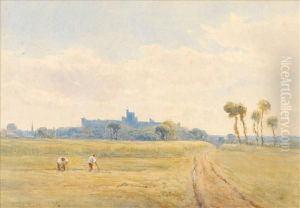W.B. Pyne Paintings
William Henry Pyne was an English painter, illustrator, and writer, born in 1769 in London. His contributions to the world of art and literature during the late 18th and early 19th centuries were significant, particularly through his detailed studies of British social history and costume. Pyne began his career as a watercolour painter, focusing on landscapes and rural scenes. He exhibited at the Royal Academy for the first time in 1790 and continued to display his works in various exhibitions, developing a reputation for his vivid and detailed paintings.
Pyne's interest in the social customs and daily lives of the British people led him to embark on an ambitious project that would make a lasting impact on the study of British history. In 1804, he initiated the publication of 'The Costume of Great Britain,' a comprehensive visual survey of the occupations, social classes, and customs of the British people. This work was comprised of sixty hand-colored engravings and detailed descriptions, offering a unique glimpse into the everyday life of Britain during this period.
Beyond his contributions to art and illustration, Pyne was also a notable writer. He authored several books on the history of art, including 'The History of the Royal Residences' in which he intricately illustrated and described the architecture and interiors of the royal palaces in England. His writings not only showcased his artistic talent but also his keen observation and research skills, making significant contributions to the documentation of British cultural history.
Despite his achievements, Pyne faced financial difficulties later in life, largely due to the ambitious nature of his projects and the high cost of producing quality engravings. He died in 1843, leaving behind a legacy of detailed visual and written records of British life and customs. Pyne's work remains a valuable resource for historians and art enthusiasts, offering insight into the social fabric of Britain during the turn of the 19th century.
